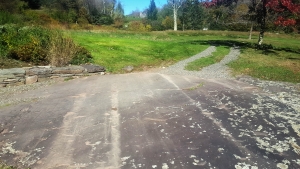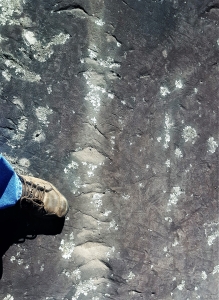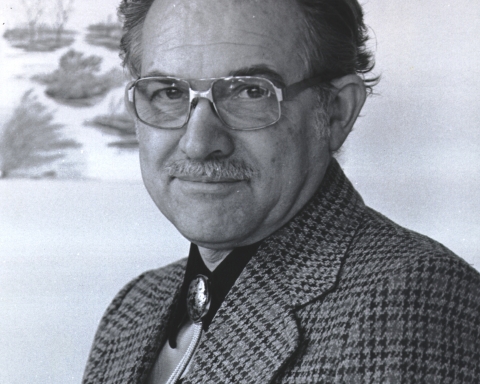Glaciers at the Arboretum
The Catskill Geologists
Robert and Johanna Titus
Have you been to the Mountain Top Arboretum? It’s in Onteora Park along Rte. 23C. The Arboretum was founded only about a quarter century ago and we have been members most of that time. It’s spread out across a couple of hundred acres of land, but the core is where the trees of the proper arboretum are, right by the road. They are young and not all that tall yet, but they are coming along.
We will be taking you there to see the geology from time to time, but let’s make our first visit today. If you visit the Arboretum you will be likely be parking in the lot right next to Rte. 23C. Right across from the parking lot, you will see the entrance to the main arboretum. There is a gate there and you can’t enter without passing through it. That’s where the geology starts.

If you look down, then you will see a flat surface of bedrock (our first photo). Look again and notice how that bedrock seems to have been smoothed out. It almost looks polished; it has been. Now look again and you will likely soon notice a series of long, very straight scratches in the rock. They are, all of them, parallel to each other. We always bring a compass along and we got it out and took some measurements. We found that all those scratches lie on a north-to-south lineation.
We had just begun a journey into the past; we were visiting the Ice Age. All that polishing was the result of a glacier passing across this surface. The bottom of that moving ice was dirty with sand, silt and clay. The ice pressed all that sediment into the ground and polished that surface. Sanded might be a better choice of words. In any case, it was the ice that produced what we see here. If you look through the gate, you will be looking north. That’s the direction from which the glacier arrived. In our mind’s eyes we could look that way and envision that glacier moving towards us.
We have seen surfaces like this many times before. But what surprised us, and what we want to talk about today was something else. Off on the right side of this outcrop we saw a pair of what are called glacial grooves. So far, we have been talking about cobbles being dragged across the surface of the bedrock. These are very good at leaving striations. But, imagine for a moment that some very large boulders were being dragged by too. You would expect them to be pressed into the ground as much or more as nearby cobbles.

Those boulders, as you would expect, were making something bigger than striations; we call them glacial grooves. Grooves are a lot wider and deeper than striations. But there is something else. Those boulders were being pressed down by the weight of the ice. That tended to hold them in place. But they were also being pushed from behind by the moving ice. For a period of time the weight of the ice did hold these boulders in place, but then the push from behind got to be so great that the boulder skipped forward in a sudden leap. When it “landed,” it created a large crescentic nick in the surface of the bedrock. We call such nicks chattermarks.
This process continued for some time. Every “leap” forward left a new chattermark, all of them nicely nested in the boulder’s groove (our second photo). That’s what we see at the Arboretum and we don’t remember ever seeing any grooves quite as good as these. They are well worth a visit.
There is one problem with today’s story. If the sunlight is just right, then you will be able to see all that we have described. But if the light is wrong . . . then you will see none of it.
=================================================================
Contact the authors at randjtitus@prodigy.net. Join their facebook page “The Catskill Geologist.”





